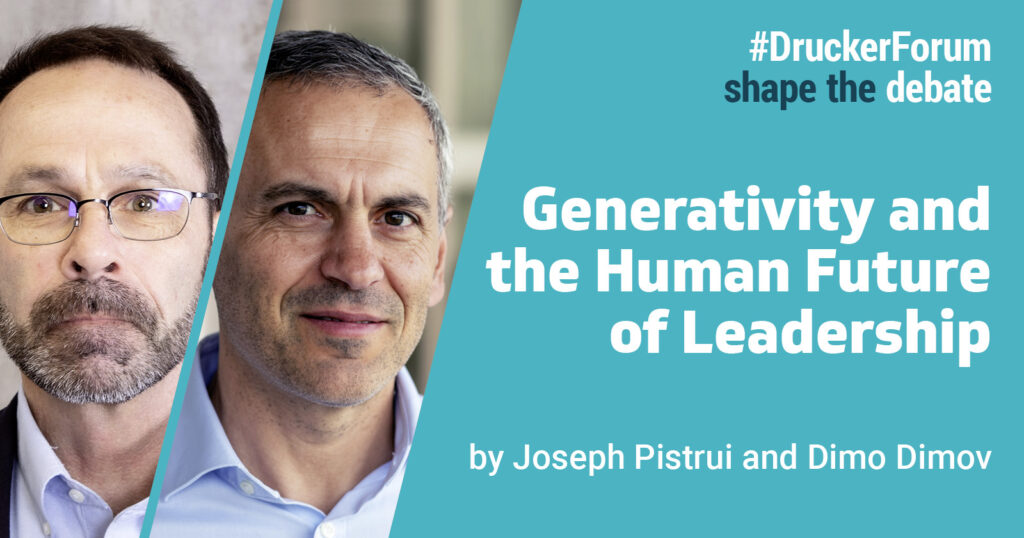
A Leadership System Under Pressure
Leadership as we’ve known it is faltering. The pace of change has outstripped our mental models, and the heroic ideal of the all-knowing leader can no longer bear the weight of complexity.
As artificial intelligence automates knowledge, institutions struggle with legitimacy, and ecosystems demand collective adaptation, the old forms of leadership—hierarchical, centralized, control-oriented—can no longer keep up.
The Drucker Forum’s 2025 theme, Next Era Leadership: All Hands on Deck, speaks to this moment. The call is not simply for inclusion, but for reinvention: a shift from leadership as command to leadership as a collective act of imagination.
From Managing to Generating
Over the past decade in this very forum, we have explored how leadership has evolved through several lenses: from manager as controller to leader as learner, from execution to exploration, and from productivity to generativity.
Each stage has expanded the scope of leadership—from the individual to the collective, from the known to the possible.
Generativity, as we now define it, is the capacity to renew and expand the inputs themselves, not merely to optimize outputs. It is the creative energy that enables individuals, teams, and organizations to evolve continuously, rather than merely perform.
If productivity was about doing things right, and innovation about doing new things, generativity is about keeping the capacity alive to imagine what comes next.
In this sense, the next era of leadership is not just about better leaders—it’s about leading generatively, designing conditions where renewal and contribution can emerge across the whole system.
The Human Roots of Generativity
Psychologist Erik Erikson first described generativity as a defining task of adulthood—the desire to care for and guide future generations. It was a deeply human impulse toward continuity and contribution, a way to find meaning by investing in what outlives us. In today’s context, that impulse must expand beyond individuals to the systems we inhabit. Organizations, like people, face the challenge of remaining alive, adaptive, and meaningful over time. Generative leadership builds on Erikson’s insight by turning care into design—creating conditions through which others and the system itself can grow. What began as a psychological concern for legacy becomes a collective practice of renewal.
Gregory Bateson later offered a complementary insight in what he called an ecology of mind—the idea that intelligence and adaptation emerge not from individuals alone but from the relationships and feedback loops that connect them and make them inseparable from their environment. Learning, in this view, is a living, recursive process of renewal. Generative leadership extends this ecological logic to organizations: it treats leadership as a shared, evolving network of sensemaking rather than a function of control. Just as healthy ecosystems sustain themselves through connection and exchange, leading systems sustain their vitality through continual learning, reflection, and contribution. In this way, generativity becomes the living pattern that keeps the human enterprise adaptive and alive.
Why “All Hands on Deck” Is a Design Principle
“All hands on deck” is often invoked in moments of crisis. But in the next era, it must become a design principle—a way of structuring participation, responsibility, and imagination.
No one mind, team, or algorithm can hold enough context to navigate what’s coming. Complexity demands diversity of perspective, and renewal demands distributed creativity. In this sense, leadership becomes a relational system—one that depends on the interplay of many minds, not a single one.
This is what Drucker anticipated when he wrote that, in the post-capitalist society, “knowledge workers must lead themselves.” The challenge today is to make that real—not as an abstraction, but as an everyday practice.
To do so, leaders must shift focus from being in charge to creating the conditions for others to lead.
A New Leading
For many, the shift from leader as a noun to leading as a verb can feel like a loss of identity—a surrender of the authority that once defined purpose. Yet the title “leader” was never meant as a laurel wreath, but as an expectation and responsibility for what one will do. What seems like loss is really a shift of locus—from control to creation. Leadership endures, but its expression changes. The “no longer leader” becomes the designer of possibility—cultivating the environment where others can grow and contribute. This new purpose carries the same intentionality as command but channels energy toward creation rather than control. To lead generatively is to find meaning not in being indispensable, but in making others capable — transforming influence from possession into propagation, and legacy from dominance into design.
Making this shift real depends on a new repertoire of practice—three meta-skills that translate generativity into daily leadership.
The Three Meta-Skills of Generative Leadership
Generative leadership depends on cultivating three essential meta-skills—capabilities that allow people and systems to navigate uncertainty and create what’s next. These meta-skills anchor leadership practice in renewal rather than control.
Mindful Aspiration
Leaders hold space for multiple possible futures and help others imagine beyond the immediate. This is not about setting static goals but about building shared foresight and purpose.
Example: LEGO’s reinvention began with a question—“What’s next for play?”—a collective act of imagination that turned crisis into renewal.
Self-Regulation
In the face of volatility, leaders need balance and discipline. Generative leadership creates “safe zones for exploration”—places where experimentation can occur without collapsing into chaos.
Example: Amazon’s staged, patient approach to developing AWS—shielded from quarterly pressures—illustrates disciplined experimentation at scale.
Reasoning Toward New Values
The essence of adaptive leadership lies in blending awareness of the present with aspiration for the future—to reason toward new forms of value.
Example: Patagonia’s call to “Don’t buy this jacket” reframed sustainability as business advantage, turning values into a vehicle for value creation.
Across all three, the leader’s work is less about decision and more about design—crafting the contexts in which creativity can thrive. Together, these meta-skills equip leaders not to control complexity, but to dance with it—turning uncertainty into a generative force.
From Leading People to Leading Systems
If the industrial age was about commanding hierarchies, and the knowledge age about connecting networks, the generative age is about leading systems—living, adaptive constellations of people, technology, and ideas that must continually renew themselves.
Leading systems means focusing less on control and more on the conditions that enable collective intelligence to flourish. It is not leadership within the system, but leadership of the system itself.
Generative leaders cultivate three essential forms of action:
- Connection – weaving relationships and shared understanding across boundaries so that information and insight circulate freely.
- Coherence – creating alignment through purpose and narrative rather than command, ensuring that diverse actions still add up to something meaningful.
- Circulation – keeping energy, ideas, and learning in motion; inviting experimentation and renewal so the system remains alive and responsive.
Leading systems in this way invites “all hands on deck” not to reinforce hierarchy but to sustain aliveness—the system’s capacity to keep learning, sensing, and evolving together.
As Peter Drucker reminded us, the task of management is always a human one: to organize human effort for meaningful contribution. Leading systems extends that insight into the present age. It asks leaders to see organizations not as machines to optimize but as living collectives to nurture and renew—places where people, knowledge, and technology co-evolve in service of purpose. The ultimate measure of such leadership is not control, but generativity—the ability to keep creating value through others and with them.
From Generativity to Collective Renewal
Generativity offers a hopeful counterpoint to the anxiety of our age. It reminds us that renewal is possible—not as a miracle, but as a method.
When leaders cultivate generativity, they create organizations that regenerate themselves. When families build generativity, they create legacies that evolve with each generation. When societies foster generativity, they turn diversity into strength.
This is not optimism for its own sake. It is a practical necessity in a world where no one can lead alone.
The Call: All Hands on Deck for Generativity
The next era of leadership demands more than new tools or new structures—it requires a new social contract, one that seeks differences to make a difference.
Generative leadership turns “all hands on deck” from a slogan into a system—a shared commitment to creating the future together. It invites everyone to participate in the work of renewal.
As Drucker might have put it: the best way to predict the future is to co-create it.
Generative leadership isn’t about steering the ship; it’s about helping everyone aboard learn to navigate, repair, and reinvent it—while at sea and as the seas themselves change. The future belongs to those who can make leadership itself generative.
About the authors:
Joseph Pistrui is co-founder of Generative Learning, Professor of Entrepreneurship & Innovation at IE University in Madrid, and a Senior Research Fellow at the Center for the Future of Organization, Drucker School of Management.
Dimo Dimov is co-founder of Generative Learning, Professor of Entrepreneurship & Innovation at University of Bath in the UK, and author of two books on entrepreneurship.

